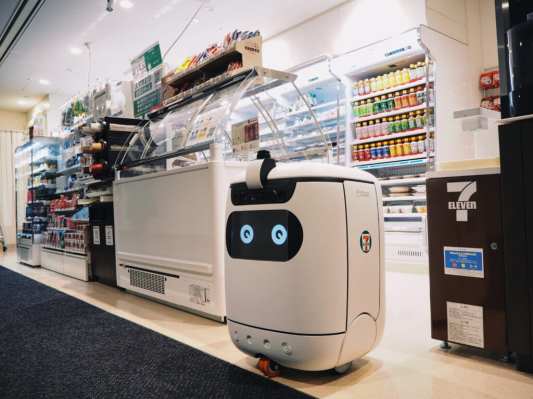In the crowded enterprise robotics space, the ability to secure key clients is a crucial differentiator for companies. In the case of Hong Kong–based Rice Robotics, the important order has come from SoftBank.
Since January 2021, Rice’s robots, with their cute, cartoonish blinking eyes, have been delivering 7-Eleven products to SoftBank staff at the company’s new headquarters in Takeshiba, Tokyo. These robots are capable of carrying a 30 kg payload and have a storage space of 39 x 27 x 34 cm.
Rice effectively allows delivery workers to simply drop off customer orders at a designated spot for its robots to fetch, eliminating the need for them to navigate in and out of office buildings. The robots can operate continuously for 12 hours and can recharge within one hour.
Recognition from SoftBank and other customers has convinced several investors to back Rice’s latest $7 million pre-Series A funding round. They include Alibaba Entrepreneurs Fund, Soul Capital, Audacy Ventures, Sun Hung Kai & Company, and Cyberport HK. There’s no lead investor in the round.
The financing, said Rice, will allow it to push farther into Japan, which is now the company’s biggest source of revenue. Aside from SoftBank, Rice also counts Toyota, Japan Post and Mitsui Group among its Japanese clients.
Japan has been a favored destination for China’s robotics companies seeking to expand internationally, given its aging population and openness to new technology. The ByteDance-backed warehouse robot maker Syrius Robotics, for example, made a foray into Japan at an early stage.
South China is no doubt the home to the world’s leading hardware supply chains. Counterintuitively, Rice makes its robots in Hong Kong instead of mainland China, where factories are abundant and labor costs are lower.
The four-year-old company previously made its robots through an original equipment manufacturer (OEM) on the mainland but discovered that manufacturing in its home city significantly brought down the unit cost of its robots, Rice’s founder and CEO Victor Lee told TechCrunch.
Manufacturing in bulk in mainland China is more economical, while Rice’s production size is too small to achieve an economy of scale, explained Lee. Furthermore, the Hong Kong government is actively trying to attract advanced manufacturing to diversify an economy that’s losing its appeal as a financial hub for Asia.
A portion of Rice’s new funding has been deployed to establish a production plant in Hong Kong. The facility, which spans an area of 13,000 square feet, has quadrupled the company’s annual production capacity from 500 to 2,000 robots.
With a starting market price of $9,000, Rice’s robots utilize the popular simultaneous localization and mapping (SLAM) technology for navigation. A big advantage of SLAM is that it continuously compares sensor data with the given map, allowing the system to construct an accurate and on-the-fly model of the environment and estimate a robot’s precise location.
Aside from service robots, Rice also offers a line of disinfection robots, demand of which surged during the COVID-19 pandemic, as was the case with many other robotics firms.
Want the top robotics news in your inbox each week? Sign up for Actuator here.
